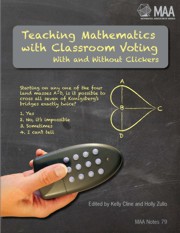Book contents
- Frontmatter
- Contents
- I An Introduction to Teaching Mathematics with Classroom Voting
- II Studies of Classroom Voting in Mathematics
- 3 Can Good Questions and Peer Discussion Improve Calculus Instruction?
- 4 Using Peer Instruction and i-clickers to Enhance Student Participation
- 5 Student Surveys: What Do They Think?
- III Classroom Voting in Specific Mathematics Classes
- Bibliography
- About the Editors
5 - Student Surveys: What Do They Think?
from II - Studies of Classroom Voting in Mathematics
- Frontmatter
- Contents
- I An Introduction to Teaching Mathematics with Classroom Voting
- II Studies of Classroom Voting in Mathematics
- 3 Can Good Questions and Peer Discussion Improve Calculus Instruction?
- 4 Using Peer Instruction and i-clickers to Enhance Student Participation
- 5 Student Surveys: What Do They Think?
- III Classroom Voting in Specific Mathematics Classes
- Bibliography
- About the Editors
Summary
Introduction
Many individual faculty have surveyed their students about classroom voting, and they generally report positive results. How robust are these results across a wide variety of students, campuses, instructors, and courses? In this study, a total of 513 students in 26 classes were surveyed regarding the use of classroom voting in their classes. (See Appendix A for the survey form.) Fourteen instructors from ten different schools participated. The classes surveyed were primarily freshman and sophomore level courses in calculus, multivariable calculus, linear algebra, and differential equations. While several questions show the variation in response that one might expect, other questions generate consistent results, showing that student opinion in these areas is uniform across many variables.
Aggregate Results
The aggregate results are overwhelmingly positive. 93% of the students surveyed say that voting makes the class more fun. While having fun certainly does not equate to learning, it is a good first step and tends to encourage attendance. 90% of the students say that voting helps them engage in the material, and 84% say it helps them learn.
Students love examples and always seem to be clamoring for more. About half of the students surveyed (48%) say that they would be better prepared for the homework and exams if the instructor did more examples on the board and less voting. Given that students are so enamored of examples, this response is not unexpected.
- Type
- Chapter
- Information
- Teaching Mathematics with Classroom VotingWith and Without Clickers, pp. 29 - 34Publisher: Mathematical Association of AmericaPrint publication year: 2011
- 9
- Cited by



